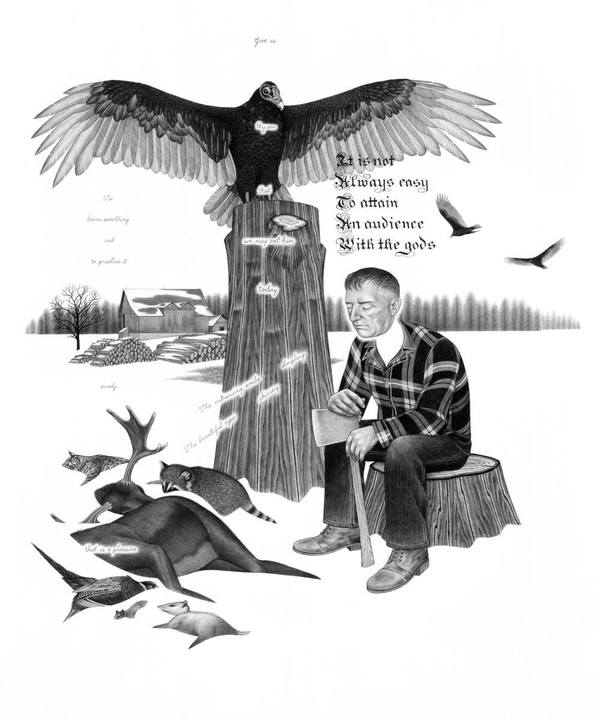This is an archive of the ArtCat Zine, 2007-2009. Please visit our new project, IDIOM.
Eric Beltz at Morgan Lehman
The Good Land
Eric Beltz
Morgan Lehman Gallery - 317 Tenth Avenue
9 October - 8 November
Eric Beltz's drawings first attract the viewer with the virtuosity of his crystal clear lines and elaborate surface patterns. When so much contemporary art smacks of an anyone-can-do-it aesthetic, this skilled draftsman wields graphite like a wand. But Beltz offers substance as well as a sophisticated technique. Viewers that dig deeper into his symbolism encounter a grisly vision of America's founding fathers. His gothic depictions may hit closer to the truth than what patriotism or good taste want us to believe.
Beltz is picky about his graphite and prefers sticks that are jet black without the onyx shimmer of cheaper, more reflective graphite. His arsenal of erasures corrects minor flaws and enables his technical perfectionism. The astute observer can still detect a ghost limb or phantom design haunting the picture plane, but they remain largely concealed.
The artist remarked to your commentator that "color for me is superfluous to my work right now." This chromatic absence draws attention to black lines as they expand, contract, intersect, compete, and run away from each other. It also assigns a pivotal role to how shading flavors perception and formal emphasis. Shapes collaborate with one another, appearing as individual leaves in one moment and then coalescing into the gestalt of a tree. These effects are not as explicit in color and can fly well under the radar in a painting -- here, though, they energize the work. Beltz's drawings reward taste for the subtleties that formally belong most clearly to drawing.
Severed heads floating above their bodies are a recurring motif. The agenda is to symbolize the disconnect between the principles and the actions of a young America's first white rulers. These men conceived bold ideals of social equality that were often riddled with caveats and inconsistencies. A profound contradiction remains between their efforts to forge a democracy rooted in equity and the privileged class that reaped the land's riches by enslaving Africans, decimating indigenous populations, and subordinating women. These works illustrate the disconnect between the mind's thoughts and the hand's commands. With skeletons, skulls, animal carcasses, weaponry and an arresting image of a slave, tarred and feather, Beltz vividly depicts a particularly American brand of death.
Text and phrases float beside most of the figures. These words often articulate the religious and ideological promises of utopia that inspired early European settlers on the American continent. Beltz's sharp juxtaposition of lofty words and bitter violence might first seem inflammatory, but this is in fact the very disjunction between reality and its ideological context that formed the young nation and paved the trail of tears.
After listening attentively to the voices of victims muted by previous histories, one becomes more and more curious about the mentality of their oppressors. Rather than indulging in tropes of monstrosity or evil, Beltz takes the risk to depict the numbingly violent landscape and the ambitious justifications of these darkly detached early Americans. With a muscular style and technique alloyed with a clever allegorical wit, Beltz's drawings dazzle and startle in sublime tandem.
ZINE
HOME
TIPS / COMMENTS
CATEGORIES
CONTRIBUTORS
- Greg Afinogenov
- B. Blagojevic
- Adda Birnir
- Susannah Edelbaum
- Julie Fishkin
- Paddy Johnson
- Jessica Loudis
- Christopher Reiger
- Andrew Robinson
- Peter J. Russo
- Blythe Sheldon
- S.C.Squibb
- Hrag Vartanian

